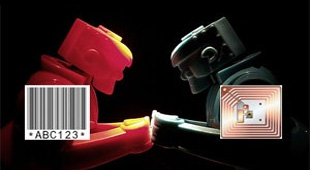In 2008, SCDigest published a framework that we hoped might be helpful or companies to think of the potential use of RFID in the context of what was then and is still now the predominant supply chain auto ID technology, bar codes.
Does that framework still hold eight years later?
Supply Chain Digest Says... |
 |
| Simple bar code replacement will create the least value, and often cause challenges with building a solid business case. |
 |
What do you say? |
| Click here to send us your comments |
 |
| Click here to see reader feedback |
|
|
Our thinking then: potential use of RFID may be thought of as occupying one of three categories relative to the current or alternative selection of bar coding for a given process or application.
1. RFID as Basic Bar Code Replacement: In these scenarios, RFID will operate really just like an "electronic bar code." Individual bar code scans are simply replaced with an RFID read. There are many examples where this type of application makes perfect sense and can deliver significant benefits. Example applications include pallet identification (e.g., in receiving or shipping), reading cartons on a conveyor system, pallet putaway, reading work-in-process totes, etc.
The advantage of RFID over bar codes in these scenarios usually relate to improved efficiency from eliminating hand scans by operators, eliminating the need for "line of sight" to read bar codes, or reducing problems with bar code read rates, as is often found in high speed carton sortation systems.
These "basic bar code replacement" applications are the easiest to implement because the fundamental business process is the same, and the underlying business software application can often remain exactly, not caring (or even knowing) whether the source of the identifier was a bar code or RFID tag.
2. Enhanced Business Process: In these cases, the basic business process remains the same, but the unique advantages of RFID begin to be more leveraged. For example, RFID might be used to simultaneously read all of the cartons on a pallet as it passes through a portal, or read all of the serial numbers virtually at once as a pallet of goods leaves a production cell.
In these scenarios, the fundamental process remains the same, but is enhanced to drive even greater productivity. A pallet of bar coded goods cannot be scanned all at once, and if bar codes on some cartons are not accessible, could not even be read manually after the pallet is built.
These types of scenarios usually do require some changes to the underlying software, which is unlikely to be developed to handle these types of simultaneous inputs, and to react to errors or misreads.
3. Designing of New Business Processes: In these applications, which are mostly still being envisioned, the underlying business process is fundamentally altered. One good example might be a RFID network in a distribution center that continually monitors all inventory in near real-time, both to keep track of the goods and their location and/or to track dwell times when inventory is not moving for how long.
(See More Below)
|
CATEGORY SPONSOR: SOFTEON |
|
|
| |
|
|
 In that scenario, traditional beliefs and processes around traditional physical inventories and cycle counting are completely turned on their heads. That means significant work in designing "as is" and "to be" processes, getting substantially more input and buy-in from multiple parties than the first two scenarios, likely significant changes to underlying software or likely adoption of new applications, substantial piloting and testing, etc. In that scenario, traditional beliefs and processes around traditional physical inventories and cycle counting are completely turned on their heads. That means significant work in designing "as is" and "to be" processes, getting substantially more input and buy-in from multiple parties than the first two scenarios, likely significant changes to underlying software or likely adoption of new applications, substantial piloting and testing, etc.
SCDigest believes that still today, as in 2008, most RFID deployments in supply chain fall under level 1. A few could be categorized as being in level 2. Most level 3 applications are still on the drawing board.
But of course, the potential value operates in reverse. Simple bar code replacement will create the least value, and often cause challenges with building a solid business case from what is almost by definition incremental improvement. Level 3 applications could generate significant value, but are the most complex and risky, and will almost certainly involve software development.
But categorizing potential RFID-based applications as falling into which scenario can help companies understand the likely impact on potential return (lowest to highest) and system software work (also lowest to highest).
Does the framework still hold? We say yes, and that it may be helpful to look for and evaluate opportunities for RFID in the supply chain.
What do you think of our three-level RFID deployment model? What would you add or change? What type of applications would you put as being in category 2 or 3? Let us know your thoughts at the Feedback button below.
Your Comments/Feedback
|